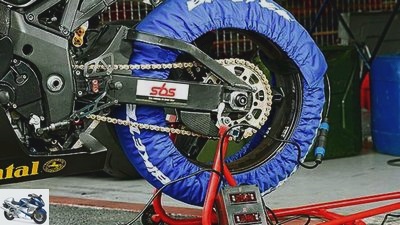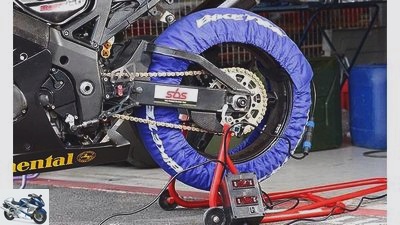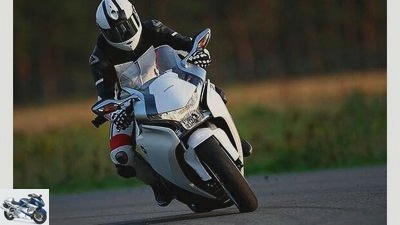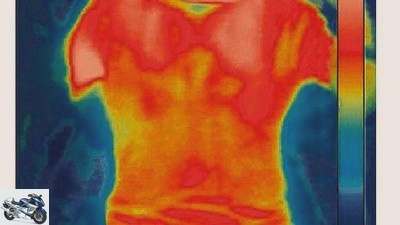Table of contents

jkuenstle.de
counselor
workshop
Driving tips: Warm up the motorcycle properly
This is how it works: Warm up the motorcycle properly
How to get your bike going
And no matter how warm it is outside – the engine, chassis, tires and brakes, the driver also need a while to get up to operating temperature.
08/08/2011
At half past five in the morning you don’t just jump out of bed and run a half marathon. After the resting phase, the circulation has to get going, the organism has to be started up. The same is true of your motorcycle with its engine, chassis, tires and brakes. Like the human cycle, they also need operating temperature for optimal readiness for use.

For specialists: so that racing motorcycles can hit the track with optimum grip, the tires are heated up before the start.
Anyone who cannot be approached in the morning before their third cup of coffee (or knows someone like that) easily understands that even the motorcycle is not available for top performance on the spot. A gentle driving style at medium speeds gradually brings the engine up to temperature.
Rule of thumb: Do not drive more than half the nominal speed for the first 5 km. This gives the oil, which is more viscous when cold, time to become thin. Then it gets everywhere and develops its full lubricity before it really gets down to business. The mixture preparation – i.e. carburetor or injection – only works precisely when
the engine has become so warm that gasoline no longer condenses on the canal walls.
The oils in the fork and shock absorber behave in a similar way to engine oil: they are thicker when cold than when they are warm. This affects the attenuation:
The spring elements respond sluggishly when driving over bumps, the motorcycle behaves stubborn and uncomfortable.

For the first 5 kilometers, start with a gentle driving style (half the nominal speed) so that the engine can warm up optimally.
Too high a speed can now easily cause chassis unrest. In addition to the spring elements, these are also attributable to the tires, because they are responsible for damping, in addition to traction: when cold, they appear glassy, reluctantly absorb shocks and give rise to unevenness in the road, e.g. B. longitudinal grooves, as unwelcome steering impulses.
Test drives with temperature sensors showed that targeted acceleration and heavy braking on a straight road are the best way to heat the tires. This is particularly easy with ABS motorcycles: Rolling upright, they can be braked vigorously in front of red traffic lights, at which you have to stop anyway. Pay attention to the traffic behind you! Only when the tires feel more elastic than on the first few meters can you drive corners bit by bit more quickly and thus bring the tire flanks up to temperature. The warm, elastic tire rubber presses into the depressions of the road surface and literally clings to it.

The truth in color: a few push-ups pumps blood to your chest muscles. The thermal imaging camera gives it away.
But not only the vehicle, the driver also wants to be brought up to temperature before the journey. Head and body have to get on the bike awake and warmed up. For example, by doing a few squats and light stretching exercises before the start, the driver ensures that the muscles are well supplied with blood, better flexibility and faster reactions. Just five minutes of warm-up training are enough to put the body and mind in a more responsive state and to prevent tension.
notes
the Front tire is still too cold if, for example, the motorcycle unwillingly turns or lags behind every longitudinal groove. When driving, a cold tire can be felt relatively quickly in the steering. Adjust your driving style accordingly!
Blunt brakes are rather rare, because most stoppers grip well even when cold. But if they feel doughy at first, bring them carefully to operating temperature by deliberately applying the brakes.
Hot-headed nobody should drive, but the body may have warmed up. You don’t have to do an endurance run for this: a few squats and relaxation exercises for the muscles of the feet, hands and neck provide sufficient preparation.
Related articles
-
MOTORCYCLE tips for racetrack training
jkuenstle.de counselor workshop MOTORCYCLE tips for racetrack training Tips for newcomers to the racetrack Always nice and slow You’ve got your hands on…
-
Braking properly with the motorcycle
Jahn counselor Driving experience & Driving tips Braking properly with the motorcycle Brake properly Braking with and without ABS Motorcycles ride well…
-
archive counselor technology & future Lateral and circumferential forces when riding a motorcycle – driving physics when riding a motorcycle About…
-
Driving tips and advice on motorcycling
fact 26th pictures MOTORCYCLE 1/26 On the way on alpine passes? That’s how it works! MOTORCYCLE 2/26 Seductive winding curves with risk. The course of…
-
Motorcycle license costs classes A2 driving school forms
Natalie Diedrichs 9 pictures Bilski 1/9 The motorcycle license is not only a permit to drive on public premises, but also for many people the ticket to…
-
mps photo studio 26th pictures Breakable 1/26 Endurance 1.) The climber uses all of your muscles. The exerciser is in an upright position. The hands…
-
Driving report Neckarsulm motorcycle from 1902
motorcycles Driving report Neckarsulm motorcycle from 1902 Driving report Neckarsulm motorcycle from 1902 At the origin 1901 and 1903 – the beginning of…
-
Pascal Eckhardt’s driving tips for the racetrack part 5
archive counselor workshop Pascal Eckhardt’s driving tips for the racetrack part 5 Pascal Eckhardt’s driving tips for the racetrack Part 5 Correct…
-
Pascal Eckhardt’s driving tips for the racetrack Concentration
fact counselor workshop Pascal Eckhardt’s driving tips for the racetrack Concentration Pascal Eckhardt’s driving tips for the racetrack Part 11 Full…
-
Book Perfectly driving a motorcycle
Tobias Rall Sports & scene Book Perfectly driving a motorcycle Book tip Perfectly driving a motorcycle The other motorcycle driving school From the…